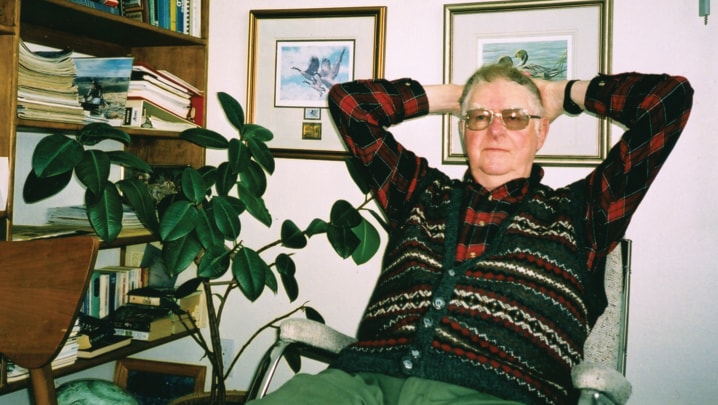In addition to friends and family, conservationists from afar will be gathering this afternoon at Bethany Lutheran Church in Dickson to honour the memory of Elmer Kure, arguably, Alberta’s greatest conservationist . . . ever.
Elmer died at 90 in the early morning of May 24th at Sunset Manor, Innisfail, his most recent residence.
Elmer came to the Dickson area from Illinois with his Danish parents when he was three. He helped clear the family land he farmed for more than 30 years. Next door to the church stands what is likely the one-room school where Elmer was educated, and which now serves as the clubhouse of the Dickson Fish and Game Association, where Elmer honed his talents for his long years of service to better the environment of all Albertans, including our fish and wildlife.
Early in his life, Elmer learned to hunt and appreciate wildlife from his father, Art Kure, and developed the passion for conservation and the strong land ethic that is characteristic of all North America’s legendary hunter-conservationists.
In 1958 Kure was persuaded to run as a wild card candidate and, to his surprise, won, becoming the Alberta Fish and Game Association’s 19th president. In 1964 the AFGA honoured Kure for his many presidential accomplishments with its highest award, the Fulton Trophy.
In the early ’70s, then AFGA president, the late Tom O’Keefe, decided the position was becoming too time consuming for one person and persuaded Elmer Kure, for a modest stipend, to serve as my executive assistant when I became AFGA president in 1973. That job was soon titled Director of Environmental and Public Relations and Kure served in it until 1986, becoming a key figure in most private and governmental conservation and fish and wildlife management issues of those golden years. For his efforts in that position, the AFGA, in1988 made Elmer Kure the only two-time recipient of its Fulton Trophy. Many other provincial and national awards came Kure’s way, including The Order of the Bighorn, then Alberta’s highest award to a conservationist, in 1989.
No initiative illustrates the principled, gentlemanly, negotiating skills of Elmer Kure quite like the work he did on Alberta’s first Buck for Wildlife project, the North Raven River restoration. Land owners along the tiny river were naturally somewhat testy, feeling blamed for the degradation and bank destruction and concerned at the prospect of easements for fishermen. The AFGA loaned Elmer Kure to the project, and he skillfully brought everyone on-side and together with such arguments as everyone wins — including increased property values — with a restored, world class trout stream running through the place.
Yesterday I looked at the new signs along the North Raven telling the story of one of North America’s more successful stream restoration projects, all the more remarkable because it was accomplished mostly on private land. Elmer was proud of that. He would also have been pleased that the new signs proclaim that you don’t have to ask anyone to fish a superbly challenging brown trout stream visited by storied fly fishermen from afar.
I often visited Elmer and spouse, Helga, at their farm home east of Spruce View, then at their new home south of Spruce View and nearer Dickson. Elmer had been instrumental in having the landowner tag established in Alberta, and on one of my visits he gave me good advice on how you hunted trophy mule deer on a single quarter section.
Then, on another visit, when Elmer was as young as I am now, a chill went up my spine when he told me he was done hunting. He told a great story, but the crux is that, hunting his beloved river quarter with a landowners’ tag, he made the only bad shot of his long hunting life and his mule deer buck got all the way across the Red Deer River before expiring. No matter that a couple of river floaters helped him recover the buck, Elmer was adamant: he was past it . . . done.
He stuck with his decision, and for two decades at least enjoyed a parade of visitors to the oracle at Dickson, many seeking his views and advice on the steadily worsening renewable resource situation in Alberta. Once I expressed frustration and mystification over the selfish attitude of big ranching to our public land, and Elmer said: “It’s all about money; follow the money and you’ll find your answer.”
More recently, discussing early aspects of Alberta’s shameful war on wildlife, Elmer and I agreed that today everything’s so all about money that soon we’ll have nothing else left. On my last visit Elmer mourned the losses of the conservation gains that were taking us back to the wasteland that was Alberta in 1908 when the AFGA started.
Don Hayden, AFGA president, 1979-81, said this immediately on hearing of Elmer Kure’s passing: “Alberta is now poorer, because when the sun set on May 24th, our conservation godfather was no longer there.”
Bob Scammell is an awarding winning outdoors writer living in Red Deer.
